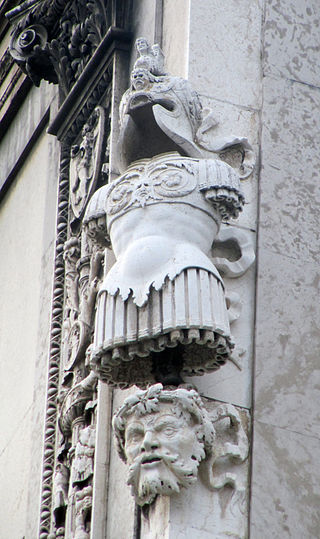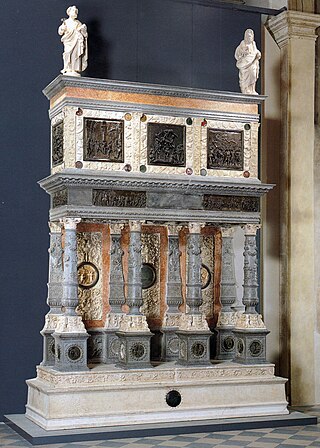
Andrea del Verrocchio was an Italian sculptor, painter and goldsmith who was a master of an important workshop in Florence.

Bartolomeo Colleoni was an Italian condottiero, who became captain-general of the Republic of Venice. Colleoni "gained reputation as the foremost tactician and disciplinarian of the 15th century". He is also credited with having refurbished the Roman baths at Trescore Balneario.

Romano di Lombardia is a comune (municipality) in the Province of Bergamo in the northern Italian region of Lombardy, located about 45 kilometres (28 mi) east of Milan and about 20 kilometres (12 mi) southeast of Bergamo. It received the honorary title of city with a presidential decree on September 17, 1962.

The Cappella Colleoni is a chapel and mausoleum attached to the Basilica of St. Mary Major in the northern Italian city of Bergamo.

The Pinacoteca Tosio Martinengo is a public art museum in Brescia, Lombardy, Italy.

The Equestrian statue of Bartolomeo Colleoni is a Renaissance sculpture in Campo Santi Giovanni e Paolo, Venice, Italy, created by Andrea del Verrocchio in 1480–1488. Portraying the condottiero Bartolomeo Colleoni, it has a height of 395 cm excluding the pedestal. It is the second major equestrian statue of the Italian Renaissance, after Donatello's equestrian statue of Gattamelata (1453).

The Royal Armoury of Turin is one of the world's most important collections of arms and armour, formed in Turin by the Savoy family. The museum is now part of the Musei Reali di Torino, the royal site that has unified the Royal Palace, the Sabauda Gallery, the Archaeological Museum, the Royal Library and the Armoury. The whole site has been included on the UNESCO World Heritage list since 1997.

Palazzo del Magnifico, also known as Palazzo Petrucci, built as the residence of Pandolfo Petrucci, is located in Siena on Piazza San Giovanni at the corner of Via dei Pellegrini.

Gasparo Cairano, also known as Gasparo da Cairano, de Cayrano, da Milano, Coirano, and other variations, was an Italian Renaissance sculptor.
Antonio della Porta, better known as Tamagnino was an Italian sculptor of the Renaissance.

Salomé is an oil painting on canvas, by Moretto da Brescia, executed c. 1540. It is kept in the collection of the Pinacoteca Tosio Martinengo in Brescia.

Bernardino delle Croci was an Italian goldsmith and sculptor of the Brescian Renaissance. He was the founder of the Delle Croci family of important goldsmiths and sculptors, known for their specialism in processional crosses, reliquaries and altars.

Bernardino da Martinengo was an Italian mason and architect. His appellation serves to identify his origins in Martinengo in the area of Bergamo. In 1481, he was cited as a member of a bricklayers group, where he learned construction techniques of the late Gothic. Towards the end of the same decade, he was registered amongst the construction workers of the Monte di Pietà vecchio, a palazzo situated in the Piazza della Loggia in Brescia, where he would be one of the accusers of Filippo Grassi, the construction manager, for fraud against the municipality.

The Altar of San Girolamo is a sculptural complex in marble, around 780×450×80cm in dimension, designed and constructed by Gasparo Cairano and Antonio Medaglia, and situated within the Church of St Francis of Assisi in Brescia, Italy. Dated between 1506–1510, it is located in the first chapel on the right side of the nave.
LudovicoBeretta was an Italian architect of the Brescian renaissance. His work is considered emblematic of the development of the Renaissance architectural paradigm in the middle of the sixteenth century.

Palazzo Averoldi is a historic building in Brescia located on Via Moretto at number 12. It was built starting in the 16th century in the middle of the southern historic center, in what was once the so-called Quadra di San Giovanni.

The Martinengo mausoleum is a funerary monument made through the use of various marbles and bronze by Gasparo Cairano, Bernardino delle Croci and probably the Sanmicheli workshop, dated between 1503 and 1518 and preserved in the museum of Santa Giulia in Brescia, in the nuns' choir.

Brescian Renaissance sculpture was an important offshoot of Renaissance sculpture developed in Brescia from around the 1460s within the framework of Venetian culture, peaking between the end of the century and the beginning of the next. In this period, a series of public and private worksites were able to produce absolutely original works, ranging from the refined and experimental sculptural style of the church of Santa Maria dei Miracoli to the regular classicism of the Palazzo della Loggia.

Piazza della Loggia, or more simply Piazza Loggia, also known as Piazza Grande or Piazza Vecchia, is one of Brescia's main squares, a symbolic place of the Brescian Renaissance and Venetian rule over Brescia.




















